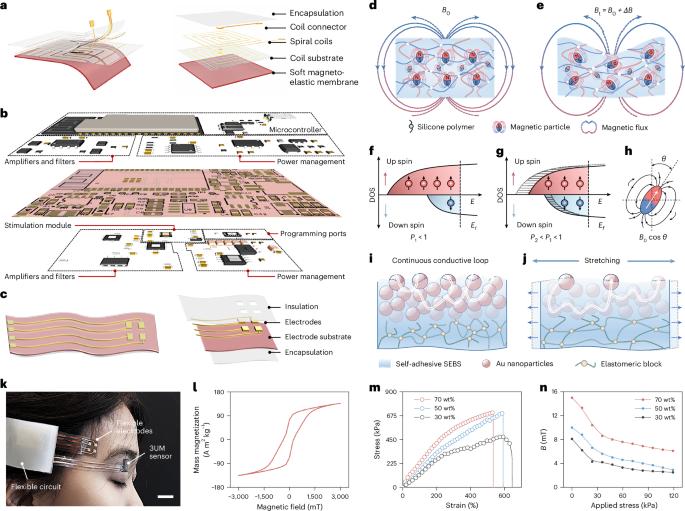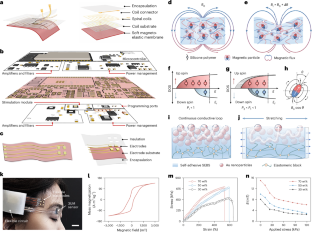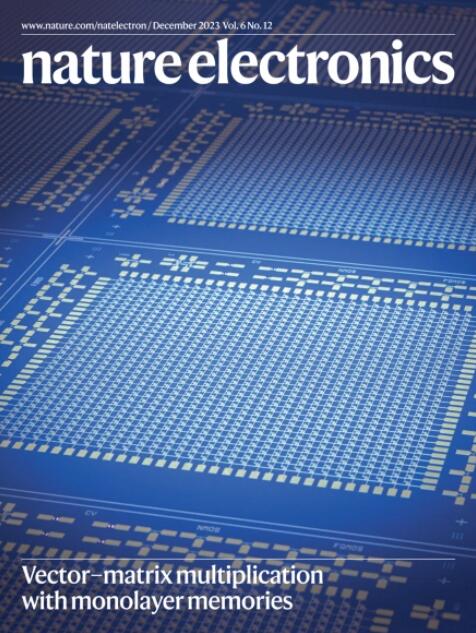一个软磁弹性传感器来解码疲劳程度
IF 40.9
1区 工程技术
Q1 ENGINEERING, ELECTRICAL & ELECTRONIC
引用次数: 0
摘要
疲劳是一种复杂的状态,其特征是一个人的精神或身体表现的下降。测量疲劳的方法包括自我报告问卷、脑电图和基于相机的技术。然而,这些方法通常局限于实验室环境,这限制了它们更广泛的可及性。在这里,我们报告了一种柔软的眼睑磁弹性传感器,可以实时捕获眨眼参数并定量解码疲劳水平。该传感器以自供电方式工作,包括由嵌入微磁体的硅橡胶基体形成的磁机械耦合层和在薄热塑性弹性体层上图案的导电金线圈。这种设计可以将眼球运动转换成高保真的电信号。该传感器的杨氏模量为200 kPa,可拉伸性高达530%,压力灵敏度为0.2µa kPa−1。它的薄膜结构与人的上眼睑组织保持保形,并在各种眼球运动中保持密切接触。当结合一维卷积神经网络和数据处理技术时,该传感器可以识别细微的眼球运动,并基于6个眨眼参数对疲劳程度进行分类,准确率为96.4%。本文章由计算机程序翻译,如有差异,请以英文原文为准。


A soft magnetoelastic sensor to decode levels of fatigue
Fatigue is a complex condition characterized by a decline in a person’s mental or physical performance. Methods to gauge fatigue include self-reported questionnaires, electroencephalography and camera-based technologies. However, these methods are typically restricted to laboratory settings, which limits their wider accessibility. Here we report a soft on-eyelid magnetoelastic sensor that can capture eye-blink parameters in real time and quantitatively decode fatigue levels. The sensor, which works in a self-powered manner, comprises a magnetomechanical coupling layer formed from a silicone rubber matrix embedded with micromagnets and a conductive gold coil patterned onto a thin thermoplastic elastomer layer. This design allows the conversion of eye movements into high-fidelity electrical signals. The sensor exhibits a Young’s modulus of 200 kPa, a stretchability of up to 530% and a pressure sensitivity of 0.2 µA kPa−1. Its thin membrane structure adheres conformally to human upper eyelid tissue and maintains intimate contact during diverse eye movements. When combined with a one-dimensional convolutional neural network and data-processing techniques, the sensor can recognize subtle eye movements and categorize fatigue levels with an accuracy of 96.4% based on six eye-blink parameters. An on-eyelid soft sensor that tracks eye movements based on the magnetoelastic effect can be used to continuously monitor and quantitatively assess levels of fatigue.
求助全文
通过发布文献求助,成功后即可免费获取论文全文。
去求助
来源期刊

Nature Electronics
Engineering-Electrical and Electronic Engineering
CiteScore
47.50
自引率
2.30%
发文量
159
期刊介绍:
Nature Electronics is a comprehensive journal that publishes both fundamental and applied research in the field of electronics. It encompasses a wide range of topics, including the study of new phenomena and devices, the design and construction of electronic circuits, and the practical applications of electronics. In addition, the journal explores the commercial and industrial aspects of electronics research.
The primary focus of Nature Electronics is on the development of technology and its potential impact on society. The journal incorporates the contributions of scientists, engineers, and industry professionals, offering a platform for their research findings. Moreover, Nature Electronics provides insightful commentary, thorough reviews, and analysis of the key issues that shape the field, as well as the technologies that are reshaping society.
Like all journals within the prestigious Nature brand, Nature Electronics upholds the highest standards of quality. It maintains a dedicated team of professional editors and follows a fair and rigorous peer-review process. The journal also ensures impeccable copy-editing and production, enabling swift publication. Additionally, Nature Electronics prides itself on its editorial independence, ensuring unbiased and impartial reporting.
In summary, Nature Electronics is a leading journal that publishes cutting-edge research in electronics. With its multidisciplinary approach and commitment to excellence, the journal serves as a valuable resource for scientists, engineers, and industry professionals seeking to stay at the forefront of advancements in the field.
 求助内容:
求助内容: 应助结果提醒方式:
应助结果提醒方式:


